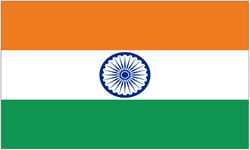| National Factbook |
| Flag: |

|
| Nation Name: |
Indian Subcontinent |
| Leader Name: |
Karthik Krishnan S |
| Currency: |

Rupee |
| National Animal: |

Tiger |
| History: |
# **The United Indian Subcontinent: An Alternate History**
### **Origins and Early Civilization (3000 BCE – 500 BCE)**
The Indian subcontinent, a land of immense diversity, saw the rise of the **Indus Valley Civilization (3000 BCE – 1500 BCE)**, one of the world’s earliest urban cultures. Cities like Harappa and Mohenjo-Daro flourished with advanced drainage systems, trade networks, and organized governance. The Vedic Age (1500 BCE – 500 BCE) followed, bringing early Hinduism, Sanskrit, and a sophisticated societal structure. Unlike in our timeline, the various kingdoms and tribes gradually united under a loose confederation, forming the earliest foundations of a single **United Bharatvarsha**.
### **Rise of the Maurya and Gupta Empires (500 BCE – 600 CE)**
The threat of **Persian** and **Greek invasions** forced the kingdoms to forge stronger ties. Chandragupta Maurya (321 BCE) consolidated power with the guidance of Chanakya, forming the Maurya Empire, which governed the subcontinent as a single entity. His grandson **Ashoka the Great** (268 BCE – 232 BCE) spread Buddhism across Asia but also implemented policies of tolerance, allowing Hinduism, Jainism, and other beliefs to flourish.
The **Gupta Empire (319 CE – 550 CE)** followed, ushering in a golden age of science, mathematics, art, and literature. Instead of fragmenting after the decline of the Guptas, the subcontinent’s rulers formed a federal structure, ensuring regional autonomy while maintaining central unity.
### **Medieval Period: A Unified Response to Invasions (600 CE – 1500 CE)**
Unlike in real history, where various Rajput, Chola, and Vijayanagara kingdoms ruled separately, the **United Subcontinent** maintained a strong confederation. Islamic invasions from the **Ghaznavids and Ghurids** (10th–12th centuries) met with a unified resistance. When the **Delhi Sultanate (1206–1526)** formed under the Mamluks and later the Tughlaqs, it became a part of the larger Indian Union, rather than a separate ruling entity.
The **Chola dynasty** expanded trade and influence to Southeast Asia, ensuring that the subcontinent remained a dominant force in global commerce. The **Bhakti and Sufi movements** flourished, creating a unique blend of Hindu and Islamic traditions.
### **The Mughal Era and Industrial Advancements (1500 CE – 1800 CE)**
The Mughals, led by **Babur (1526)**, were welcomed as partners in governance rather than conquerors. **Akbar the Great (1556–1605)** played a crucial role in consolidating the diverse regions under a **unified imperial rule**, where Hindus, Muslims, Sikhs, and others coexisted peacefully. This ensured long-term stability.
The subcontinent, now referred to as the **Bharatiya Samrajya (Indian Empire)**, became a hub of innovation. The Mughal-era industrial boom led to the widespread use of **steam-powered looms** and **early mechanized production**, making India the **world’s largest economy**. When the **British East India Company** arrived in the 1600s, they found a powerful, industrialized empire resistant to colonization.
### **Colonialism Averted: Indian Industrial Revolution (1800 CE – 1900 CE)**
The Indian Empire, having embraced early industrialization, prevented the British from gaining control. European powers had to negotiate trade instead of enforcing colonial rule. Indian entrepreneurs established industries in textiles, metallurgy, and shipbuilding, competing with European manufacturers.
A major **technological leap** occurred when Indian engineers adopted **railways, steam engines, and telegraph systems** in the early 1800s, keeping pace with European developments. Education reforms created **universities in Nalanda, Varanasi, and Lahore**, making India a **center for science and research**.
### **The 20th Century: A Global Superpower Emerges (1900 CE – 1950 CE)**
With its economic and military strength, the **Indian Subcontinent Union (ISU)** became a key player in global politics. During **World War I**, ISU provided technological and strategic support to the Allies, ensuring a quicker victory. By **World War II**, the subcontinent had its own advanced military, making any external invasion impossible.
The period also saw a flourishing of democratic ideals. The **first general elections** in 1935 created a **federal parliamentary system**, balancing central and regional powers.
### **The Modern Era: Leader of the Global South (1950 CE – 2025 CE)**
By the late 20th century, the **Indian Subcontinent Union** was the **second-largest economy**, after the U.S. The **Green Revolution**, led by Indian scientists, ensured food security. The **IT and space sectors** grew, with the **Chandrayaan Program** putting an Indian on the Moon by 2020.
Today, the **Indian Subcontinent** is a **permanent UNSC member**, a leader in AI, biotech, and quantum computing, and a bridge between the East and West. Its diversity, once seen as a challenge, has become its greatest strength, making it a true global superpower. |
| Geography |
| Continent: |
Asia |
| Land Area: |
1,126.54 sq. km |
| Terrain: |
The Himalayas in the north, the Indian Ocean in the South, Tropical rainforests in the Northeast, Large number of rivers mainly draining into the Bay of Bengal. Highest peak in the world Mt Everest in the state of Nepal. |
| Highest Peak: |
Mt Everest, 0 meters |
| Lowest Valley: |
Kuttanad, -2 meters |
| Climate: |
Tropical in the South, Cold in the north, Hot and Humid in the west |
| People & Society |
| Population: |
47,339 people |
| Demonym: |
Indian |
| Demonym Plural: |
Indian |
| Ethnic Groups: |
Indo-European - 70.0%
Dravidians - 25.0%
Sino-Tibetan - 3.0% |
| Languages: |
Hindi - 45.0%
Bengali - 20.0%
Urdu - 18.0% |
| Religions: |
Hinduism - 75.0%
Islam - 22.0%
Christianity - 2.5% |
| Health |
| Life Expectancy: |
68 years |
| Obesity: |
14% |
| Alcohol Users: |
6% |
| Tobacco Users: |
29% |
| Cannabis Users: |
3% |
| Hard Drug Users: |
0.5% |
| Economy |
| Description: |
### **The Economy of the United Indian Subcontinent: A Global Powerhouse**
The **United Indian Subcontinent (UIS)**, stretching from Afghanistan to Myanmar and Sri Lanka, is a **global economic superpower**. With a population of **1.9 billion people**, abundant natural resources, a massive industrial base, and cutting-edge technology, the UIS has built an economy that rivals the United States and China. Let’s explore its economic structure, key industries, and global impact.
---
## **1. Economic System: A Mixed Economy with Federal Governance**
The **UIS follows a mixed economy model**, balancing capitalism with social welfare. Inspired by its historical strengths, the economic structure is based on:
- **Decentralized Federalism:** Each state or province controls local industries, taxation, and infrastructure.
- **Central Economic Planning:** The national government sets macroeconomic policies, trade regulations, and large-scale infrastructure projects.
- **Private Sector Growth:** A **thriving startup ecosystem**, industrial giants, and agricultural cooperatives coexist with state-owned enterprises.
- **Social Welfare Policies:** Free healthcare, universal education, and employment guarantees ensure high living standards.
The **currency, the Bharatiya Rupaya (BR)**, is one of the strongest in the world, with a stable exchange rate due to a trade surplus and a gold-backed reserve system.
---
## **2. Key Economic Sectors**
### **A. Agriculture and Agro-Tech: The Food Hub of the World**
UIS has one of the most advanced agricultural sectors, exporting grains, dairy, and spices worldwide.
- **Green Revolution 2.0:** Genetic engineering, vertical farming, and AI-driven irrigation make UIS the largest food exporter.
- **Precision Agriculture:** Farmers use AI drones, IoT sensors, and blockchain for transparent supply chains.
- **Agro-Exports:** Rice, wheat, tea, coffee, and spices dominate global markets, with major exports to Africa, Europe, and the Americas.
---
### **B. Manufacturing and Heavy Industry: The Global Workshop**
The UIS is **the world's largest manufacturing hub**, overtaking China and the EU.
- **Textiles and Apparel:** Indian textiles have dominated global markets since the Mughal era. Today, smart fabrics, sustainable cotton, and automation make UIS the leader in fashion exports.
- **Automobile Industry:** Companies like Tata-Hyundai, Bajaj-Auto, and Mahindra lead the electric vehicle (EV) revolution.
- **Aerospace and Defense:** UIS manufactures military jets, spacecraft, and satellites, exporting to allied nations.
---
### **C. Technology and Innovation: The Silicon Subcontinent**
The UIS is the world’s **largest IT powerhouse**, surpassing Silicon Valley.
- **AI and Quantum Computing:** Bengaluru, Hyderabad, and Karachi form the **AI Triangle**, producing cutting-edge innovations.
- **Telecom and 6G Networks:** The UIS leads global 6G deployment, ensuring high-speed connectivity for its vast population.
- **FinTech Revolution:** With **UPI 3.0**, blockchain-based transactions, and digital banking, cash is nearly obsolete.
---
### **D. Energy and Infrastructure: Self-Sufficiency Achieved**
The UIS has achieved **energy independence**, balancing sustainability with industrial growth.
- **Renewable Energy Dominance:** Solar farms in Rajasthan, wind energy from Tamil Nadu, and hydro projects in the Himalayas power industries and cities.
- **Nuclear and Hydrogen Power:** Nuclear fusion reactors and hydrogen fuel cells replace fossil fuels.
- **Smart Cities and Bullet Trains:** From Delhi to Dhaka and Colombo to Kabul, high-speed rail networks connect the subcontinent seamlessly.
---
### **E. Services and Tourism: The Cultural Capital of the World**
UIS is the **world’s largest services economy**, with tourism, finance, and entertainment booming.
- **Medical Tourism Hub:** The UIS offers affordable, world-class healthcare, attracting millions of international patients.
- **Bollywood and Tollywood Dominate Media:** With film industries in Mumbai, Chennai, Lahore, and Dhaka, UIS produces **50% of global cinema content**.
- **Financial Services:** Mumbai and Karachi rival London and New York as major banking centers.
---
## **3. Trade and Global Influence**
UIS follows a **"Look Global, Act Local"** policy, maintaining strong trade ties across continents.
- **Bharat Silk Road:** A modern trade corridor linking Southeast Asia, Central Asia, and Europe boosts exports.
- **South Asian Economic Alliance (SAEA):** UIS leads a trade bloc uniting ASEAN, Africa, and the Middle East.
- **Digital Rupee in Global Trade:** The **Bharatiya Rupaya** is a reserve currency, used in international trade alongside the Dollar, Euro, and Yuan.
---
## **4. Social and Economic Development**
Despite rapid industrialization, **UIS ensures inclusive growth**, making it one of the happiest nations.
- **100% Literacy Rate:** Free education and digital learning ensure a skilled workforce.
- **Universal Basic Income (UBI):** AI-driven job displacement is balanced by a robust social security system.
- **Affordable Housing and Smart Cities:** Sustainable housing and urban planning keep living costs low.
---
## **5. Future Prospects: The Next Frontier**
The **UIS continues to shape the future** with ambitious projects:
- **Mars Colonization Program:** Space agencies in Bengaluru and Islamabad plan human settlements on Mars.
- **AI-Governance:** Automated policymaking and blockchain-driven administration improve efficiency.
- **Human-AI Symbiosis:** Research into neural interfaces and biotech enhances human potential.
With a strong economy, technological leadership, and social welfare, the **United Indian Subcontinent stands as the world’s most influential economic power**, redefining the global order.### **The Economy of the United Indian Subcontinent: A Global Powerhouse**
|
| Average Yearly Income: |
$62.34 |
| Gross Domestic Product (GDP): |
$29,337,415.00 |
| GDP per Capita: |
$619.72 |
| Gross National Income (GNI): |
$16,161,835.00 |
| Industries: |
|
| Military |
| History: |
|
| Soldiers: |
0 |
| Tanks: |
0 |
| Aircraft: |
0 |
| Ships: |
0 |
| Missiles: |
0 |
| Nuclear Weapons: |
0 |
| Last Updated: 03/04/2025 06:34 am |













